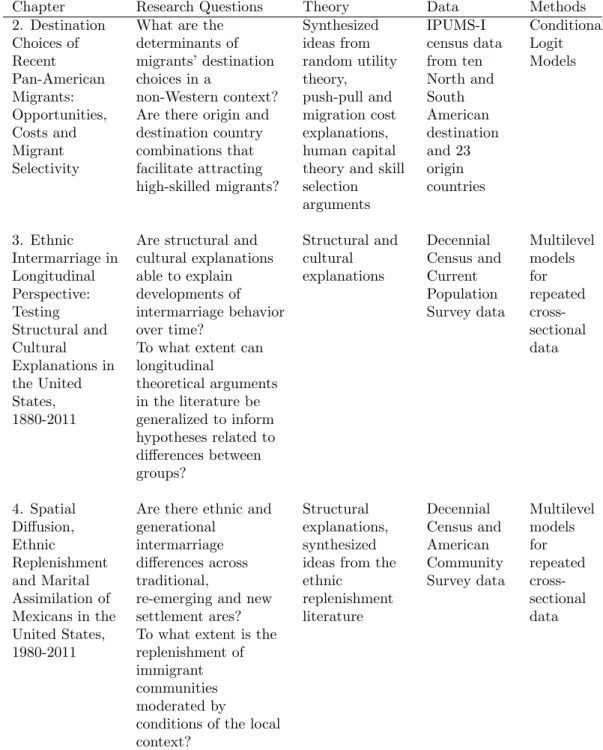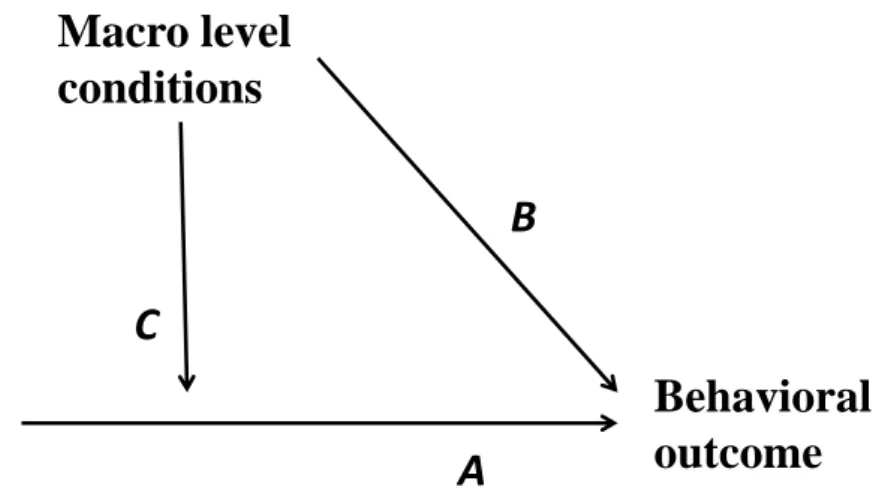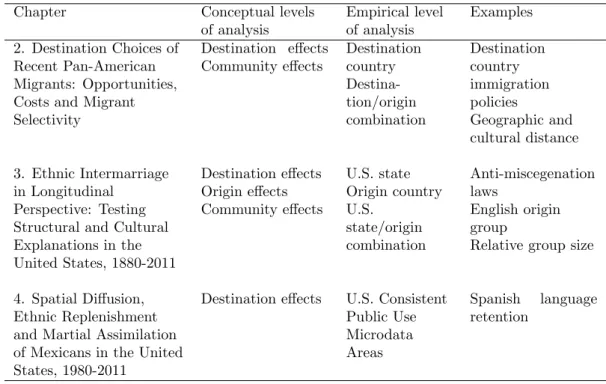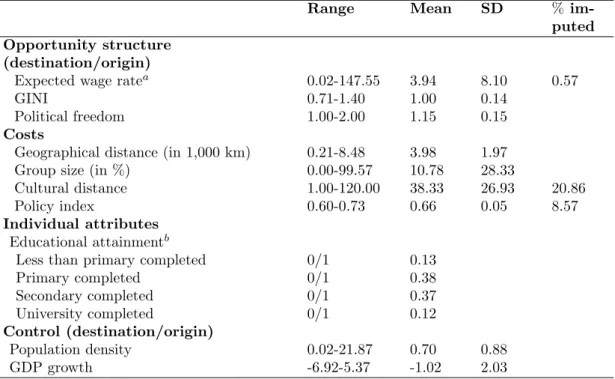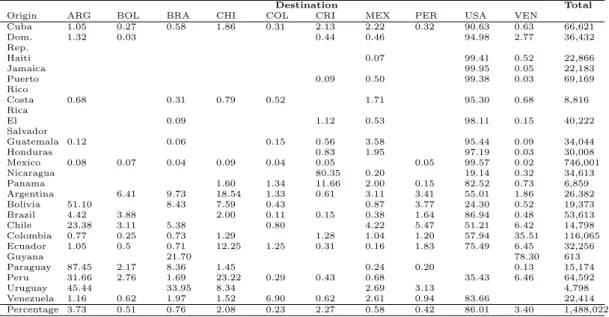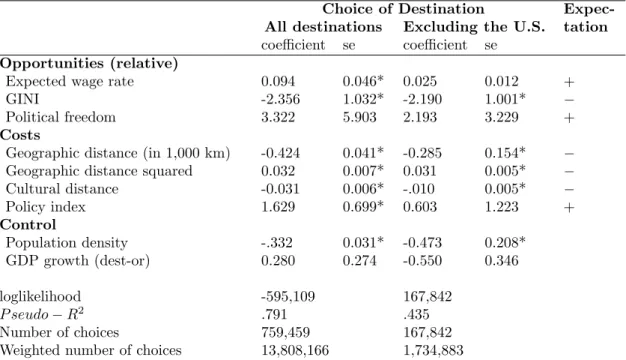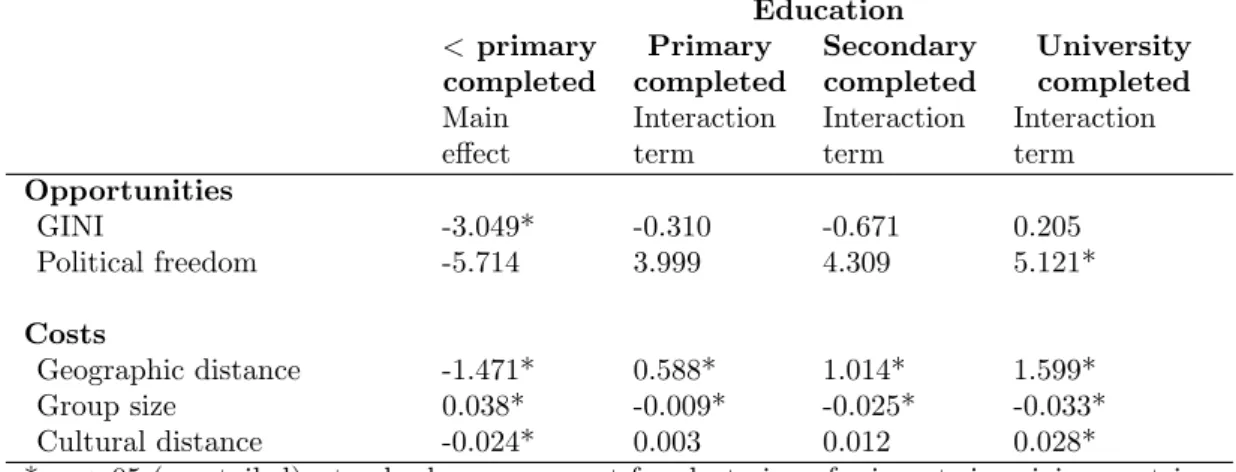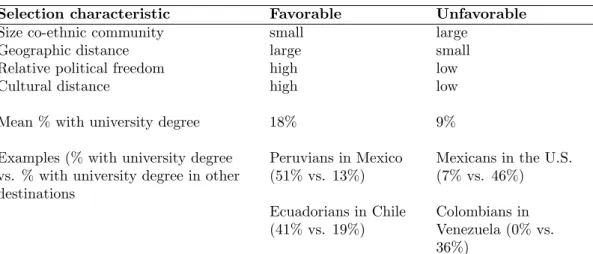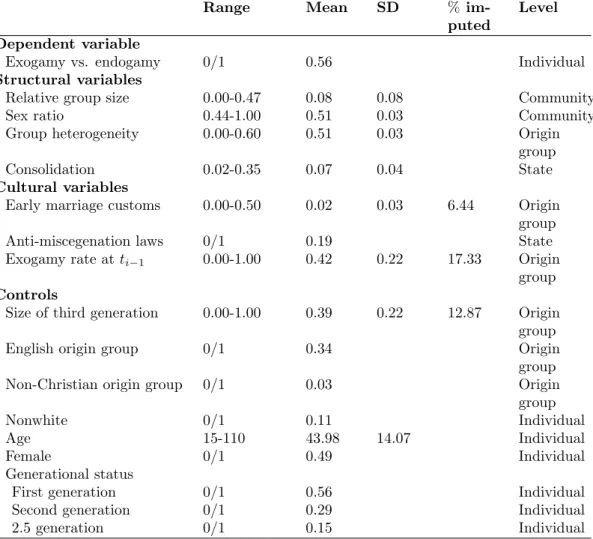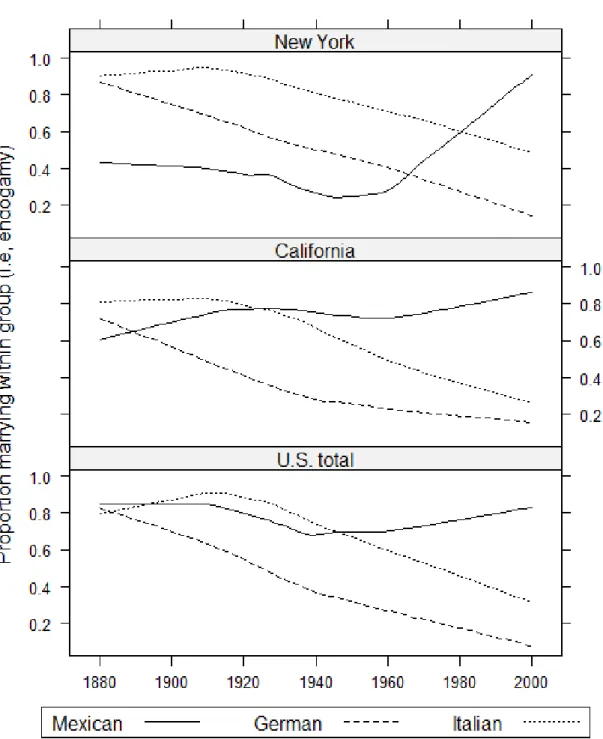Choice of Destination to Social Integration
Inauguraldissertation zur
Erlangung des Doktorgrades der
Wirtschafts- und Sozialwissenschaftlichen Fakult¨ at der
Universit¨ at zu K¨ oln 2014
vorgelegt von
M.Sc. Christoph Sp¨ orlein
aus
Bamberg
Koreferent: Prof. Dr. Elmar Schl¨ uter
Tag der Promotion: 18.09.2014
Vielen herzlichen Dank an Prof. Dr. Elmar Schl¨ uter, Prof. Dr.
Karsten Hank, Prof. Dr. Frank van Tubergen und Prof. Dr. Ted Mouw f¨ ur die zahlreichen Anregungen und die Unterst¨ utzung bei der Vollendung dieser Dissertation. Ich habe viel durch den Austausch mit euch gelernt und bin dankbar meine wissenschaftliche Laufbahn mit euch begonnen zu haben.
Auch m¨ ochte ich mich f¨ ur die finanzielle Unterst¨ utzung der Cologne Graduate School in Management, Economics and Social Sciences, der SOCLIFE Research Training Group und insbesondere bei Frau Dr.
Weiler f¨ ur den reibungslosen, organisatorischen Ablauf meiner Pro- motionszeit herzlich bedanken.
Vielen herzlichen Dank auch an Prof. Dr. Clemens Kroneberg und seine Familie. An mein Semester als wissenschaftlicher Mitarbeiter erinnere ich mich gerne zur¨ uck.
Schammelsdorf, den 01.07.2014 Christoph Sp¨ orlein
List of Figures vii
List of Tables ix
1 Introduction 1
1.1 Research questions . . . . 3
1.2 Multilevel concepts: research designs and methods . . . . 8
1.3 Appendix: Contributions of co-authors . . . . 15
References . . . . 19
2 Destination Choices 29 2.1 Introduction . . . . 29
2.2 Theoretical perspective . . . . 33
2.2.1 Opportunity structure in origin and destination countries . 35 2.2.2 Incorporating the cost of migration . . . . 37
2.3 The Latin-American Context . . . . 41
2.4 Data and Methods . . . . 43
2.4.1 Method . . . . 44
2.4.2 Explanatory variables . . . . 45
2.5 Results . . . . 48
2.5.1 Descriptive results . . . . 48
2.5.2 Multivariate results . . . . 49
2.6 Illustrating Results . . . . 54
2.7 Conclusion and Discussion . . . . 57
2.8 Appendix . . . . 61
References . . . . 63
3 Ethnic Intermarriage 73 3.1 Introduction . . . . 73
3.2 Theory . . . . 78
3.2.1 Structural Explanations . . . . 80
3.2.2 Cultural Explanations . . . . 83
3.3 Data and Methods . . . . 86
3.3.1 Methods . . . . 87
3.3.2 Measures . . . . 89
3.4 Results . . . . 95
3.4.1 Descriptive results . . . . 95
3.4.2 Variance partition . . . . 99
3.4.3 Multivariate results . . . 100
3.4.4 Illustrating the multivariate findings . . . 105
3.5 Conclusion . . . 107
3.6 Appendix . . . 112
References . . . 114
4 Diffusion, Replenishment and Assimilation 125 4.1 Introduction . . . 125
4.2 Literature Review . . . 129
4.2.1 The Spatial Diffusion of Mexicans across the United States 129 4.2.2 Trends in Mexican/White Intermarriage . . . 132
4.3 Data and Methods . . . 136
4.3.1 Data . . . 136
4.3.2 Methods . . . 136
4.3.3 Measures . . . 138
4.4 Results . . . 141
4.4.1 Descriptive results . . . 141
4.4.2 Variance partition . . . 145
4.4.3 Multivariate results . . . 147
4.4.3.1 Interethnic marriage . . . 148
4.4.3.2 Intergenerational marriage . . . 151
4.4.3.3 Ethnic replenishment . . . 152
4.5 Conclusion and discussion . . . 155
4.6 Appendix . . . 160
References . . . 161
1.1 Conceptual multilevel model . . . . 10 3.1 Variation in endogamy rates across origin groups, states and com-
munities (1880-2011), weighted and smoothed. . . . 97 4.1 The percentage share of Mexican couples across c-PUMAs . . . . 130 4.2 Mexican/White intermarriage rates across time, generational sta-
tus and settlement area . . . 143 4.3 Mexican intergenerational marriage rates across time, generational
status and settlement areas . . . 144
1.1 Overview of research questions, theoretical ideas, data sources and methods . . . . 9 1.2 Overview of conceptual and empirical multilevel models . . . . 14 2.1 Descriptive statistics for independent variables (N=78,832) . . . . 47 2.2 Percentage of Origin Group choosing Destination, weighted . . . . 49 2.3 Conditional Logit Model of Migrants’ Choice of Destination, weighted
(N=78,832) . . . . 50 2.4 Variation of Destination Characteristics’ Attractiveness for Edu-
cational Groups, weighted (N=78,832) . . . . 53 2.5 Illustrative Selection Differentials . . . . 55 2.6 Variable definitions and sources . . . . 61 3.1 Descriptive Statistics for Dependent and Independent Variables
(N=2,559,595) . . . . 93 3.2 Top5 Origin Groups with the Highest and Lowest Endogamy Rate
(weighted) . . . . 98 3.3 Multilevel Logistic Regression of Immigrants’ Marital Choices in
the United States, 1880-2011. . . 101 3.4 Robustness checks, additional specifications. . . 112 4.1 Descriptive statistics of independent variables (N=175,660) . . . . 140 4.2 Mexican ethnic and generational intermarriage over time . . . 142 4.3 Variance components and random time slope . . . 146 4.4 Multilevel logistic regression 1
stgeneration Mexican ethnic marital
behavior across settlement areas, 1980-2012. . . 148
4.5 Multilevel logistic regression of 2
nd+generation Mexican ethnic marital behavior across settlement areas, 1980-2012. . . 150 4.6 Multilevel logistic regression of 2
nd+generation Mexican intergen-
erational marital behavior across settlement areas, 1980-2012 . . . 152 4.7 Multilevel logistic regression of 1
stgeneration Mexican intergener-
ational marital behavior across settlement areas, 1980-2012 . . . . 160
Introduction
Now, more than ever, international migration represents a social phenomenon shaping the lives of a continuously growing number of individuals. For a myriad of reasons, individuals take it upon themselves to leave their country of origin in order to move to another country. Since the 1980’s, the number of international migrants has almost steadily increased (Zlotnik 2005). In 2010, an estimated 214 million people worldwide, corresponding to about 3 percent of the world population, lived outside their country of birth (IOM 2010). This development is mirrored closely by scientific research interest further attesting to its social relevance. According to the citation indexing service “Web of Knowledge”, pub- lications in peer-review journals broadly dealing with the subject of “immigrants”
have grown exponentially from the 1930’s (114 publications) to the 2000’s (24,609 publications). In the years from 2010 to 2012 alone, 13,492 articles have been published on the topic of immigrants.
Despite the ever-growing attention migration-related topics receive in the so-
ciological literature, there remain numerous gaps deserving attention. Thus, the
purpose of this dissertation study is to contribute to the literature in ways that
will further the endeavor of eventually closing these gaps. In order to provide new insights into the process of immigrant integration, this study investigates selected episodes that migrants experience during the processes of leaving their country of origin, of settling into their destination countries, and experiencing daily life in their destination country.
1In short, the first article “Destination Choices of recent Pan-American Migrants: Opportunities, Costs and Migrant Selectivity” examines how characteristics of the country of origin and the country of destination shape migrants’ destination choices (Chapter 2). The second article “Ethnic Intermar- riage in Longitudinal Perspective: Testing Structural and Cultural Explanations in the United States, 1880-2011 ”, co-authored by Elmar Schl¨ uter and Frank van Tubergen, takes a closer look at one aspect of immigrants’ social integration by investigating how structural and cultural conditions shape intimate relations with members of the mainstream population (Chapter 3). The third and final article
“Spatial Diffusion, Ethnic Replenishment and Marital Assimilation of Mexicans in the United States, 1980-2011 ”, co-authored by Ricardo Martinez-Schuldt and Ted Mouw expands on the second article by focusing on the martial behavior of one immigrant group which has recently experienced tremendous geographical desegregation (Chapter 4).
1
The specific contributions of co-authors are listed in the Appendix at the end of this chapter.
1.1 Research questions
First research question:
The first dissertation project examines destination choices of pan-American mi-
grants. The majority of international migrants (∼60 percent) choose a country of
destination among the developed regions of the world; the remaining 40 percent
have opted for less developed countries. The proportion of individuals migrat-
ing between less developed countries roughly corresponds to the proportion of
individuals moving from less developed countries to developed countries (∼34
percent). The remaining 26 percent migrate between developed countries (IOM
2010). Thus, there seems to be a mismatch in the literature on destination choices
between the relative importance of receiving contexts and the attention the var-
ious contexts have received in terms of research carried out in these settings. Up
until now, destination choice research is mainly focused on explaining the flow of
migrants from less developed to developed regions (Karemera et al. 2000; Kim
and Cohen 2010; Mayda 2010). There is very little knowledge as to whether the
mechanisms driving migration from less developed to developed regions are also
at play when investigating migration across less developed regions. These mech-
anisms predominantly relate to push-pull explanations of international migration
as well as migration cost explanations (Lee 1966; Portes and B¨ or¨ ocz 1989; Jasso
and Rosenzweig 1990; Zimmermann 1996). A primary motive for this project
therefore rests on assessing whether preconceived explanations for the Western
context can be generalized to the situation in other parts of the world. However,
this project adds another twist to prior research in that it investigates individ-
ual choices rather then the flow of individuals between countries. It is further
assumed that these destination choices are inextricably connected to migrants’
country of origin. One major advantage of analyzing individual choices lies in the possibility of testing for variations in destination country attractiveness by individual characteristics such as human capital endowment. This is commonly referred to as migrant skill selectivity in the literature and has been shown to have important implications for the labor market incorporation of immigrants (Borjas 1989; Van Tubergen et al. 2004; Greenwood and McDowell 2011). Thus, to in- vestigate explanations of destination choices among less developed nations and potential skill selection differentials associated with these choices, the following research question is formulated:
What are the determinants of migrants’ destination choices in a non- Western context? Are there origin and destination country combina- tions that facilitate attracting high-skilled migrants?
The second research question:
The second project investigates the marital behavior of immigrants in the United
States covering a 130 year period. In the literature, the frequency of marriage
between members of ethnic minorities and members of the majority population
is seen as the litmus test of assimilation (Kalmijn 1998; Alba and Nee 2003; Wa-
ters and Jim´ enez 2005). Immigrant groups are said to be more assimilated, the
higher the rate of intermarriage with the native-born population. Differences in
the rates of intermarriage across national origin groups are commonly explained
using structural and cultural explanations (Blau and Schwartz 1984; Kalmijn
1998). Accordingly, structural explanations refer to factors that shape mating
opportunities on the local marriage market whereas cultural explanations relate to individuals’ norms and preferences regarding intergroup contacts. While these explanations are routinely employed to explain differences across origin groups, very few studies use them to explain why some groups become more “open” over time while others do not (Qian and Lichter 2011). Studies that do investigate changes in patterns of intermarriage over time only do so descriptively (Fryer 2007; Fu and Heaton 2008; Gullickson 2006; Fu 2010). While documenting so- cietal developments is an important aspect of sociology, we may gain a better understanding of these developments when we identify the underlying mecha- nisms that facilitate them. Using structural and cultural explanations to explain longitudinal developments also serves to shed some light into contradictory re- sults in the literature. Among others, Hwang et al. (1997) present conflicting evidence regarding the influence of group diversity on origin group differences in intermarriage. This could be related to the fact that the authors derive hypothe- ses from theories that are longitudinal in nature (Blau and Schwartz 1984). In other words, theoretical mechanisms that rely heavily on longitudinal reasoning are applied to cross-sectional situations which may potentially lead to faulty or in- adequate conclusions (Curran and Bauer 2011; Fairbrother and Martin 2013). By using a recent methodological innovation to disentangle longitudinal and cross- sectional mechanisms, this project aims to provide a more systematic test of the determinants of intermarriage. Hence, the following research questions are formulated:
Are structural and cultural explanations able to explain developments
of intermarriage behavior over time? To what extent can (longitudi-
nal) theoretical arguments in the literature be generalized to inform
hypotheses related to differences between origin groups?
The third research question:
The third and final project takes a closer look at the questions raised in the sec- ond project by focusing attention on a single origin group, namely Mexicans. In a series of articles, Qian and Lichter demonstrated that national trends in inter- marriage between Whites and Hispanics slowed down and in some instances even declined since the 1990s (Qian and Lichter 2007, 2011). The same authors also document an increase in marriages bridging generations suggesting a process of reconnection between Mexican immmigrants and 2
nd+generation Mexcians that could further accelerate the slowing down of assimilation trends (Lichter et al.
2011). The 1990s also saw an unprecendented diffusion of Mexicans across the United States (Durand et al. 2000; Lichter and Johnson 2009; Massey 2010).
Regions with previously little migrant settlement experienced large percentage
growth leading to the formation of new and re-emerging settlement areas outside
of traditional gateway communities (Singer 2004). From an assimilation perspec-
tive, national trends of intermarriage and spatial diffusion seem irreconcilable
since Mexicans experienced increases in spatial assimilation while simultaneously
becoming less assimilated in terms of intermarriage. One possible explanation
could be that the highly aggregate nature of previous research masks intergroup
dynamics at smaller geographic units. In general terms, one would expect the
structural meeting opportunties to vary substantially across settlement areas war-
ranting a closer inspection of associated intermarriage differentials. One aim of
this project is thus to reexamine and disaggregate intermarriage trends in order
to arrive at a more nuanced picture of Mexican assimilation pathways. Another important aspect of this puzzle refers to the constant replenishment of Mexican communities with new immigrants. Many authors have connected this aspect to recent increases in generational intermarriage (Jim´ enez 2008; Lichter et al.
2011). Accordingly, generational intermarriage could increase through shared experiences of nativism which might in effect strenghen intergroup boundaries.
Alternatively, however, intragroup challenges of ethnic authenticity may deter cross-generational marriages at the same time(Jim´ enez 2008). Thus, the impact of increases in Mexican origin population on intermarriage may depend on local conditions. This project therefore aims to test these ideas quantitatively using methods that again disentangle cross-sectional from longitudinal effects. More specifically, the third projects deals with the following research questions:
Are there ethnic and generational intermarriage differences across tra- ditional, re-emerging and new settlement areas? To what extent is the effect of immigrant community replenishment on intermarriage mod- erated by conditions of the local context?
To summarize, this dissertation study aims (1) to move migration research beyond
the Western context by analyzing destination choices in non-Western societies, (2)
to move migration research beyond mere descriptions by analyzing longitudinal
developments of intermarriage in the United States and (3) to move migration re-
search beyond established methodology by applying choice models to international
migration and by applying recent methodological innovations in multilevel mod-
els to the study of intermarriage patterns. For each chapter, Table 1.1 presents
a short overview over each research question, the associated theoretical ideas, the data sources and methods used to test hypotheses.
1.2 Multilevel concepts: research designs and methods
Although the dissertation projects tackle three very different aspects of immigrant
integration, the theoretical and empirical investigations are based on one common
underlying conceptual approach, namely multilevel modeling. The central tenet
of multilevel modeling conceptualizes individual behavioral outcomes to also be
shaped by factors located on hierarchically higher societal levels in addition to
individual characteristics (Blalock 1984; DiPrete and Forristal 1994; Goldthorpe
1997; Raudenbush and Byrk 2002. The “frog pond effect” represents one clas-
sic sociological example to illustrate a situation where behavioral outcomes are
shaped by the context. Accordingly, educational researchers frequently docu-
ment that students from competitive academic environments are less likely to
select high-performance career fields leading the author of one of the classic stud-
ies to remark that “it is better to be a big frog in a small pond than a small frog
in a big pond” (Davis 1966, p. 31). Figure 1.1 shows a visual representation of
general conceptual multilevel models. Considering the “frog pond effect” again,
there is no doubt that individual characteristics such as scholastic aptitude affect
the selection of career fields (arrow A). However, over and on top of individual
level differences, the academic environment exerts influence on career field choices
in that a higher degree of competitiveness may reduce the likelihood of opting for
Table 1.1: Overview of research questions, theoretical ideas, data sources and methods
Chapter Research Questions Theory Data Methods
2. Destination Choices of Recent Pan-American Migrants:
Opportunities, Costs and Migrant Selectivity
What are the determinants of migrants’ destination choices in a
non-Western context?
Are there origin and destination country combinations that facilitate attracting high-skilled migrants?
Synthesized ideas from random utility theory, push-pull and migration cost explanations, human capital theory and skill selection arguments
IPUMS-I census data from ten North and South American destination and 23 origin countries
Conditional Logit Models
3. Ethnic Intermarriage in Longitudinal Perspective:
Testing Structural and Cultural Explanations in the United States, 1880-2011
Are structural and cultural explanations able to explain developments of intermarriage behavior over time?
To what extent can longitudinal
theoretical arguments in the literature be generalized to inform hypotheses related to differences between groups?
Structural and cultural explanations
Decennial Census and Current Population Survey data
Multilevel models for repeated cross- sectional data
4. Spatial Diffusion, Ethnic
Replenishment and Marital Assimilation of Mexicans in the United States, 1980-2011
Are there ethnic and generational
intermarriage differences across traditional,
re-emerging and new settlement ares?
To what extent is the replenishment of immigrant communities moderated by
conditions of the local context?
Structural explanations, synthesized ideas from the ethnic
replenishment literature
Decennial Census and American Community Survey data
Multilevel
models
for
repeated
cross-
sectional
data
Behavioral outcome Macro level
conditions
Individual
characteristics A
C
B
Figure 1.1: Conceptual multilevel model
high-performance fields (arrow B). For completeness sake, arrow C denotes situ- ations in which the influence of individual characteristics on behavioral outcomes is moderated by the context. In the context of the “frog pond” example, this could refer to the observation that the impact of scholastic aptitude on career field choice is stronger in more competitive environments.
Although educational research constitutes the classic field of applying multi- level theories and methodology due to ubiquitous hierarchical clustering of stu- dents in classes and schools, approaching research questions with multilevel con- cepts has penetrated virtually all fields of sociology during the last 20 to 30 years including, of course, migration research. Examples range from research on labor market integration (Van Tubergen et al. 2004; Fleischmann and Dronkers 2010;
Koopmans 2010; Levanon 2011; Phythian et al. 2011; Pichler 2011) intergroup
relations (Lievens 1998; Kalmijn and van Tubergen 2010; Kalmijn 2012; Schl¨ uter
2012), language acquisition (Van Tubergen and Kalmijn 2005; Hwang and Xi
2008; Braun 2010; Van der Silk 2010), anti-immigrant sentiment (Pichler 2010;
Strabac 2011; Schl¨ uter et al. 2013), health and life satisfaction (Safi 2010; Hank 2011; Huijts and Kraaykamp 2012; Lee and Ono 2012) to educational outcomes (Levels et al. 2008; Van de Werfhorst and Mijs 2010; Teltemann and Windzio 2011; Verwiebe and Riederer 2013).
Although applications are very diverse, they all share the underlying concep- tual idea that some sort of context exerts influence on individual behavior in addition to individual characteristics. This could be as “simple” as a two-level conceptual model where some behavioral outcome of immigrants is thought to be shaped by conditions they for instance experienced in their origin country. A great majority of all studies in the field of migration research adopting a multi- level framework assume that where people come from is an important explanation of behavioral differences. And indeed, these “origin effects” are found to be of substantive impact on a host of outcomes. For example, the political stability of migrant’s country of origin is positively related to their labor market inte- gration as well as their children’s performance in school (Van Tubergen et al.
2004; Levels et al. 2008). Moreover, economic and social integration is lower for migrants coming from non-Christian origin countries in predominantly Christian destination countries (Van Tubergen et al. 2004; Kalmijn and van Tubergen 2010.
Similarly, higher linguistic distance towards English deters language acquisition
in the United States (Hwang and Xi 2008). These findings all underline one basic
idea: people grow up and are shaped in a cultural, economic or political envi-
ronment that to some extent travels with them when they migrate to another
country and subsequently affects their success regarding destination country in-
tegration. “Origin effects” are an integral part of one dissertation project (see
Table 1.2). For example, the results in Chapter 3 “Ethnic Intermarriage in Lon-
gitudinal Perspective” suggest that immigrants from non-Christian origin groups are less likely to marry outside their own ethnic group.
In a similar vein, the country migrants choose to move to has important ramifications for integration. Destination countries differ for instance in terms of immigration policies, labor market conditions or political orientation, all of which have been shown to play a role in some part of immigrants’ day to day lives. For example, living in a country of destination with a left-wing government in place can have both positive and detrimental effects on immigrant integration. The presence of left-wing governments has been shown to promote employment of im- migrants on the one hand, while on the other hand immigrants are less proficient in the destination country language (Van Tubergen et al. 2004; Van Tubergen and Kalmijn 2005). Moreover, it has been shown that more permissive immigrant in- tegration policies are associated with lower levels of anti-immigrant sentiment (Schl¨ uter et al. 2013). Again, these findings regarding “destination effects” stress the idea that immigrant integration can play out very differently depending on the context individuals migrate into. The concept of “destination effects” is found throughout this dissertation study. For example, the results presented in Chapter 4 “Spatial Diffusion, Ethnic Replenishment and Marital Assimilation of Mexicans in the United States, 1980-2011” indicate that increases in the Mexican population reduce intermarriage more strongly in contexts where feelings towards Hispanics are more negative.
A third and final important concept in multilevel research are “community
effects”. The reasoning underlying community effects pertains to the idea that
origin and destination effects are not orthogonal but rather interact under certain
circumstances. Consider again the finding in the literature that non-Christian
immigrants are doing less well in the labor markets of predominantly Christian destination countries. If we were to expand the study population to non-Christian destination countries, “non-Christian origin” would cease to be a pure origin effect since it is not being “non-Christian” per se that deters labor market integration but rather that immigrants do not share the same religion as the majority. In other words, the underlying mechanism for this labor market penalty is cultural distance instead of being “non-Christian”. Relative group size constitutes an- other prominent example of community effects in the literature. Accordingly, immigrant groups that constitute a larger share of a destination country’s total population are on average healthier, show higher math achievement in school but are less proficient in the destination country language (Van Tubergen and Kalmijn 2005; Levels et al. 2008; Huijts and Kraaykamp 2012). As with “des- tination effects”, “community effects” constitute an important conceptual idea in all projects of this dissertation study. For example, the findings reported in Chapter 2 “Destination Choices of Recent Pan-American Migrants” show that migrants are more likely to move to destination countries that are geographically and culturally close to the country of origin.
Please note that origin, destination, and community effects are merely con- ceptual ideas that help researchers understand and categorize the myriad ways in which behavioral outcomes can be affected by sources other than individual differ- ences. Depending on the research design, these sources are subject to adaptations.
A cross-national study is very likely to make use of a double comparative research
design with an origin/destination/community conceptualization since immigrants
are by design clustered in origin groups and destination countries. Comparative
research relating to a number of origin groups within one destination country (or
Table 1.2: Overview of conceptual and empirical multilevel models
Chapter Conceptual levels
of analysis
Empirical level of analysis
Examples 2. Destination Choices of
Recent Pan-American Migrants: Opportunities, Costs and Migrant Selectivity
Destination effects Community effects
Destination country Destina- tion/origin combination
Destination country immigration policies
Geographic and cultural distance 3. Ethnic Intermarriage
in Longitudinal Perspective: Testing Structural and Cultural Explanations in the United States, 1880-2011
Destination effects Origin effects Community effects
U.S. state Origin country U.S.
state/origin combination
Anti-miscegenation laws
English origin group
Relative group size
4. Spatial Diffusion, Ethnic Replenishment and Martial Assimilation of Mexicans in the United States, 1980-2011
Destination effects U.S. Consistent Public Use Microdata Areas
Spanish language retention
more rarely considering one origin in multiple destination countries) are more prone to use a single comparative design. However, it is still possible to adhere to a double comparative design by replacing destination effects with lower level
“state effects” or “region effects”. This exemplifies the attraction and flexibility
of this research design. Table 1.2 presents an overview of the conceptual and
empirical multilevel models used in this study. Since the dissertation projects
presented in the following chapters deal with varied and distinct aspects of immi-
grant integration that require the application of theories with explanatory power
regarding one aspect but not another, the double comparative research design
provides the unifying conceptual foundation.
1.3 Appendix: Contributions of co-authors
Chapter 3 “Ethnic Intermarriage in Longitudinal Perspective: Testing Structural and Cultural Explanations in the United States, 1880-2011” has been co-authored by Prof. Dr. Elmar Schl¨ uter, Universit¨ at Gießen, and Prof. Dr. Frank van Tubergen, Universiteit Utrecht. I am the first author and this chapter has been published under the same title in Social Science Research 43, 1-15.
Christoph Sp¨ orlein
• Conceptualization
• Development of theoretical framework
• Compilation of the research literature
• Data collection
• Data preparation
• Empirical analysis
• Discussion of the results
Elmar Schl¨ uter
• Discussion regarding the analytical and empirical interrelations
• Discussion regarding the methodological approach
• Review and discussion of the results
• Support in revisions during the submission process
• General suggestions for improvement
Frank van Tubergen
• Support in developing the theoretical framework
• Support in revisions during the submission process
• General suggestions for improvement
Chapter 4 “Spatial Diffusion, Ethnic Replenishment and Marital Assimilation of Mexicans in the United States, 1980-2011” has been co-authored by Ricardo Martinez-Schuldt and Prof. Dr. Ted Mouw, both University of North Carolina at Chapel Hill. I am the first author.
Christoph Sp¨ orlein
• Conceptualization
• Development of theoretical framework
• Compilation of the research literature
• Data collection
• Data preparation
• Empirical analysis
• Discussion of the results
Ricardo Martinez-Schuldt
• Review and discussion of the results
• General suggestions for improvement
Ted Mouw
• Discussion regarding the analytical and empirical interrelations
• Discussion regarding the methodological approach
• Review and discussion of the results
• General suggestions for improvement
References
Alba, R. and Nee, V. (2003). Remaking the American Mainstream: Assimilation and Contemporary Immigration. Harvard University Press, Cambridge. 4
Blalock, H. M. (1984). Context-effects models: Theoretical and methodological issues. Annual Review of Sociology, 10:353–372. 8
Blau, P. M. and Schwartz, J. (1984). Crosscutting Social Circles: Testing a Macrostructural Theory of Intergroup Relations. Academic Press, New York.
4, 5
Borjas, G. J. (1989). Economic theory and international migration. International Migration Review, 23:457–485. 4
Braun, M. (2010). Foreign language proficiency of intra-european migrants: A multilevel analysis. European Sociological Review, 26:603–617. 10
Curran, P. J. and Bauer, D. J. (2011). The disaggregation of within-person and between-person effects in longitudinal models of change. Annual Review of Psychology, 62:583–619. 5
Davis, J. A. (1966). The campus as a frog pond: An application of the theory of relative deprivation to career decisions of college men. American Journal of Sociology, 72:17–31. 8
DiPrete, T. A. and Forristal, J. D. (1994). Multilevel models: Methods and substance. Annual Review of Sociology, 20:331–357. 8
Durand, J., Massey, D. S., and Charvet, F. (2000). The changing geography of mexican immigration to the united states: 1910-1996. Social Science Quarterly, 81:5–15. 6
Fairbrother, M. and Martin, I. W. (2013). Does inequality erode social trust?
Results from multilevel models of U.S. states and counties. Social Science
Research, 42:347–360. 5
Fleischmann, F. and Dronkers, J. (2010). Unemployment among immigrants in European labour markets: An analysis of origin and destination effects. Work and Employment, 24:337–354. 10
Fryer, R. G. (2007). Guess who’s been coming to dinner? Trends in interracial marriage over the 20th century. Journal of Economic Perspectives, 21:71–90. 5 Fu, V. K. (2010). Remarriage, delayed marriage, and black/white intermarriage,
1968-1995. Population Research and Policy Review, 29:687–713. 5
Fu, X. and Heaton, T. B. (2008). Racial and educational homogamy: 1980 to 2000. Sociological Perspectives, 51:735–758. 5
Goldthorpe, J. H. (1997). The integration of sociological research and theory:
Grounds for optimism at the end of the twentieth century. Rationality and Society, 9:405–426. 8
Greenwood, M. J. and McDowell, J. M. (2011). USA immigration policy, source- country social programs, and the skill composition of legal USA immigration.
Journal of Population Economics, 24:521–539. 4
Gullickson, A. (2006). Black/white interracial marriage trends, 1850-2000. Jour- nal of Family History, 31:289–312. 5
Hank, K. (2011). Societal determinants of productive aging: A multilevel analysis across 11 european countries. European Sociological Review, 27:526–541. 11 Huijts, T. and Kraaykamp, G. (2012). Immigrants health in europe: A cross-
classified multilevel approach to examine origin country, destination country, and community effects. International Migration Review, 46:101–137. 11, 13 Hwang, S.-S., Saenz, R., and Aguirre, B. E. (1997). Structural and assimilation-
ist explanations of Asian American intermarriage. Journal of Marriage and Family, 59:758–772. 5
Hwang, S.-S. and Xi, J. (2008). Structural and individual covariates of English
language proficiency. Social Forces, 86:1079–1104. 10, 11
IOM (2010). World Migration Report 2010. The Future of Migration: Building Capacities for Change. International Organization for Migration. 1, 3
Jasso, G. and Rosenzweig, M. R. (1990). The New Chosen People: Immigrants in the United States. Russell Sage Foundation, New York. 3
Jim´ enez, T. R. (2008). Mexican immigrant replenishment and the continuing significance of ethnicity and race. American Journal of Sociology, 113:1527–
1567. 7
Kalmijn, M. (1998). Intermarriage and homogamy: Causes, patterns, trends.
Annual Review of Sociology, 24:395–421. 4
Kalmijn, M. (2012). The educational gradient in intermarriage: A comparative analysis of immigrant groups in the United States. Social Forces, 91:453–476.
10
Kalmijn, M. and van Tubergen, F. (2010). A comparative perspective on inter- marriage: Explaining differences among national-origin groups in the United States. Demography, 47:459–479. 10, 11
Karemera, D., Iwuagwu, V., and Davis, B. (2000). A gravity model analysis of international migration to North America. Applied Economics, 32:1745–1755.
3
Kim, K. and Cohen, J. E. (2010). Determinants of international migration flows to and from industrialized countries: A panel data approach beyond gravity.
International Migration Review, 44:899–932. 3
Koopmans, R. (2010). Trade-offs between equality and difference: Immigrant in- tegration, multiculturalism and the welfare state in cross-national perspective.
Journal of Ethnic and Migration Studies, 36:1–26. 10
Lee, E. S. (1966). A theory of migration. Demography, 1:47–57. 3
Lee, K. S. and Ono, H. (2012). Marriage, cohabitation, and happiness: A cross- national analysis of 27 countries. Journal of Marriage and Family, 74:953–972.
11
Levanon, A. (2011). Ethnic social capital: Individual and group level sources and their economic consequences. Social Science Research, 40:77–86. 10
Levels, M., Dronkers, J., and Kraaykamp, G. (2008). Immigrant childrens educa- tional achievement in Western countries: Origin, destination, and community effects on mathematical performance. American Sociological Review, 73:835–
853. 11, 13
Lichter, D. T., Carmalt, J. H., and Qian, Z. (2011). Immigration and intermar- riage among Hispanics: Crossing racial and generational boundaries. Sociolog- ical Forum, 26:241–264. 6, 7
Lichter, D. T. and Johnson, K. M. (2009). Immigrant gateways and hispanic migration to new destinations. International Migration Review, 43:496–518. 6 Lievens, J. (1998). Interethnic marriage: Bringing in the context through multi-
level modelling. European Journal of Population, 14:117–155. 10
Massey, D. S., editor (2010). New Faces in New Places. The Changing Geography of American Immigration. Russell Sage Foundation, New York. 6
Mayda, A. M. (2010). International migration: A panel data analysis of the determinants of bilateral flows. Journal of Population Economics, 23:1249–
1274. 3
Phythian, K., Walters, D., and Anisef, P. (2011). Predicting earnings among immigrants to Canada: The role of source country. International Migration, 49:129–154. 10
Pichler, F. (2010). Foundations of anti-immigrant sentiment: The variable na- ture of perceived group threat across changing European societies, 2002-2006.
International Journal of Comparative Sociology, 51:445–469. 10
Pichler, F. (2011). Success on European labor markets: A cross-national compar-
ison of attainment between immigrant and majority populations. International
Migration Review, 45:983–978. 10
Portes, A. and B¨ or¨ ocz, J. (1989). Contemporary immigration: Theoretical per- spectives on its determinants and modes of incorporation. International Mi- gration Review, 23:606–630. 3
Qian, Z. and Lichter, D. T. (2007). Social boundaries and marital assimilation:
Interpreting trends in racial and ethnic intermarriage. American Sociological Review, 72:68–94. 6
Qian, Z. and Lichter, D. T. (2011). Changing patterns of interracial marriage in a multiracial society. Journal of Marriage and Family, 74:1065–1084. 5, 6 Raudenbush, S. W. and Byrk, A. S. (2002). Hierarchical Linear Models: Appli-
cation and Data Analysis Methods. Russell Sage Foundation. 8
Safi, M. (2010). Immigrants life satisfaction in Europe: Between assimilation and discrimination. European Sociological Review, 26:159–176. 11
Schl¨ uter, E. (2012). The inter-ethnic friendships of immigrants with host-society members: Revisiting the role of ethnic residential segregation. Journal of Eth- nic and Migration Studies, 38:77–91. 10
Schl¨ uter, E., Meulemann, B., and Davidov, E. (2013). Immigrant integration policies and perceived group threat: A multilevel study of 27 Western and Eastern European countries. Social Science Research, 42:670–682. 11, 12 Singer, A. (2004). The Rise of New Immigrant Gateways. Center on Urban and
Metropolitan Policy. 6
Strabac, Z. (2011). It is the eyes and not the size that matter: The real and per- ceived size of immigrant populations and anti-immigrant prejudice in Western Europe. European Societies, 13:559–582. 11
Teltemann, J. and Windzio, M. (2011). The cognitive exclusion of young immi- grants in comparative perspective: The role of institutions and social structure.
Berliner Journal f¨ ur Soziologie, 21:335–361. 11
Van de Werfhorst, H. G. and Mijs, J. J. B. (2010). Achievement inequality and the institutional structure of educational systems: A comparative perspective.
Annual Review of Sociology, 36:407–428. 11
Van der Silk, F. W. P. (2010). Acquisition of Dutch as a second language: The ex- planative power of cognate and genetic linguistic distance measures for 11 West European first languages. Studies in Second Language Acquisition, 32:401–432.
10
Van Tubergen, F. and Kalmijn, M. (2005). Destination-language proficiency in cross-national perspective: A study of immigrant groups in nine Western countries. American Journal of Sociology, 110:1412–1457. 10, 12, 13
Van Tubergen, F., Maas, I., and Flap, H. (2004). The economic incorporation of immigrants in 18 Western societies: Origin, destination, and community effects. American Sociological Review, 69:701–724. 4, 10, 11, 12
Verwiebe, R. and Riederer, B. (2013). The reading literacy of immigrant youth in Western societies: A multilevel analysis based on pisa 2000 to 2009. Zeitschrift f¨ ur Soziologie, 42:201–221. 11
Waters, M. C. and Jim´ enez, T. R. (2005). Assessing immigrant assimilation: New empirical and theoretical challenges. Annual Review of Sociology, 31:105–125.
4
Zimmermann, K. F. (1996). European migration: Push and pull. International Regional Science Review, 19:95–128. 3
Zlotnik, H. (2005). International migration trends since 1980. In International Mi-
gration and the Millenium Development Goals: Selected Papers of the UNFPA
Experts Meeting, pages 13–25. United Nations Population Fund, New York. 1
Pan-American Migrants:
Opportunities, Costs and Migrant Selectivity
Christoph Sp¨ orlein
This study examines the destination choices of pan-American mi- grants using census data for migrants from 23 Latin-American and Caribbean origin groups opting for one of ten North and South Ameri- can destination countries. Descriptive findings suggests that Caribbean and Central American migrants overwhelmingly migrate to the United States, while South Americans show more diverse choice patterns.
Using discrete choice models, the multivariate analysis shows that
migrants are more likely to choose a country of destination which
portrays a higher relative expected wage ratio, a lower relative in-
come inequality, a smaller geographic as well as cultural distance, a
larger co-ethnic community and policy conditions that are more fa-
vorable towards immigrants. The results also indicate that some of
these characteristics lead to skill selection differentials. Accordingly,
destinations are more likely to attract highly educated migrants if
the co-ethnic community is small and relative political freedom, geo-
graphic distance and cultural distance are above average.
Destination Choices of recent Pan-American Migrants:
Opportunities, Costs and Migrant Selectivity
2.1 Introduction
International migration represents a global phenomenon with an ever-growing
number of states joining the ranks of sending and/or receiving nations (Castles
and Miller 2009; UN 2009; Cohen 2010). Western societies continue to be at-
tractive destinations as is apparent in their high and increasing net immigration
rates. As more former third-world countries like some nations in Latin-America
have successfully completed the transition to emerging markets, so too has their
attractiveness as viable migration destinations risen. Although 17 of the 28 coun-
tries with the highest share of migrants are non-Western, little research has been
done so far investigating the destination choices of migrants to non-Western (e.g.,
Latin-American) destinations (Zlotnik 2005).
From a theoretical perspective, two approaches to the cross-national study of immigrants’ choice of destination can generally be distinguished: some authors investigate the stock or flow of migrants using a comparatively large number of origin groups and destination countries (i.e., flow models) while others rely on modeling individual level choices in order to determine why destination coun- tries differ in their attractiveness to different origin groups (e.g., Funkhouser and Ramos 1993; Karemera et al. 2000; Funkhouser 2009; Kim and Cohen 2010;
Mayda 2010). Both approaches reach similar conclusions attesting to the im- portance of geographic distance between origin and destination, the size of the co-ethnic community in the destination country and economic as well as cultural factors in determining the attractiveness of destination countries. However, in flow models it is (implicitly) assumed that effects of macro characteristics such as the destinations’ ethnic composition are the same across different demographic groups (e.g. educational groups). Research using choice models suggests that this is not necessarily the case showing that for instance the importance of siz- able co-ethnic communities diminishes with immigrants’ educational attainment (Funkhouser and Ramos 1993; Liaw 2007). Hence, it is largely low educated mi- grants that choose destinations where many members of the same origin group live. However these cross-national choice studies comprise only a comparatively small number of origin groups and destination countries.
This papers aims to contribute to cross-national research on migrants’ choice
of destination countries by synthesizing several ideas from the literature and
testing them in a new context: First, flow and choice approaches to the study of
migrants destination choices are combined by studying a larger number of origin
groups and destinations while simultaneously retaining the possibility that macro
characteristics affect these choices differently for different demographic groups.
The choice models used in this study move beyond pure flow (or gravity) mod-
els by allowing researchers to directly model the underlying choice bevahior that
ultimately manifests itself in the flows of people between countries. More impor-
tantly, these choice models simultaneously model micro and macro level forces
while ow models exclusively deal with questions revolving around macro processes
shaping the ow of people. Doing so enables researchers to move the focus back on
individuals who are faced with difcult choices and to recognize the variation across
choices within origin groups. Consequently, a number of hypotheses elucidating
on differences in the hypothesized effects of macro characteristics for certain de-
mographic groups are derived. These moderating relationships are argued to
extend and add to skill selection arguments advanced by the human capital lit-
erature. Migrants’ destination choices are modeled using individual level census
data on 23 origin groups and 10 North and South American destination coun-
tries. Hypotheses are tested using discrete choice modeling. Second, theoretical
arguments are phrased in relative terms. Within a random utility maximization
framework, it is argued that migrants choose the destination with the highest
utility relative to their origin country. By doing so, it is recognized that the de-
cision for a specific destination may be inextricably connected with the situation
in immigrants’ country of origin. It thus accounts for the presence of origin and
destination effects in migration research (cf. Van Tubergen et al. 2004). This
relative model formulation readily allows incorporating push-pull arguments into
a random utility theory framework. Third, a broader set of explanatory factors is
investigated. Apart from established explanations including economic conditions,
size of the co-ethnic community and geographical distance, hypotheses on the role
of immigration policies, political conditions, social welfare/income inequality and
cultural distance are formulated. Furthermore, a number of hypotheses eluci-
dating on differences in the hypothesized effects for certain demographic groups
are derived. These moderating relationships are argued to extend and add to
skill selection arguments advanced by the human capital literature. And fourth
since discrete choice models assume that all relevant alternatives are included,
this study focuses on the destination choices of Latin-American and Caribbean
origin groups. Latin-American and Caribbean origin groups are an exceptional
test case as more than 80 percent of their migrants move to destinations within
the Americas (Migration DRC 2007). In light of the model assumptions, this
context thus provides an appropriate testing ground for the theoretical model.
2.2 Theoretical perspective
In the literature on migratory patterns, individuals are assumed to undertake migratory behavior to improve upon some part of their living conditions (Massey et al. 1998). Potential migrants face a set of feasible alternatives (i.e. destina- tion countries) and choose the destination country which provides (1) the best opportunities under consideration of the (2) associated costs of migrating to each specific destination (Borjas 1989; Karemera et al. 2000). In order to explain mi- grants’ destination choices, an integrative model is formulated drawing on ideas derived from random utility theory, push-pull explanations and theories of mi- grant selectivity.
This article follows an approach that is adopted from a concept known as “ref- erence dependent decision making” in a random utility framework (e.g. Camerer 1995; Sugden 2003; K¨ oszegi and Rabin 2006; Masatlioglu and Ok 2006). In this approach, individuals’ choices are made under consideration of the status quo:
“the status quo position of a decision maker affects the behavior of the agent even if the agent chooses to move away from her status quo” (Masatlioglu and Ok 2006, p. 2). This implies that potential migrants take their pre-migration situation into account when choosing a viable country of destination. For instance, individuals from high-income origin countries will perceive the income level in a potential destination differently than individuals from low-income countries (Davies et al.
2001). Hence, the underlying mechanism guiding migrants’ choice of destination
suggests that an alternative becomes attractive when it leads to an improvement
over living conditions experienced in the status quo, i.e. the country of origin
conditions.
In practice, this approach allows for the incorporation of push-pull expla- nations (Lee 1966; Portes and B¨ or¨ ocz 1989; Zimmermann 1996). On the one hand, push factors induce migratory behavior due to unfavorable conditions in the country of origin. On the other hand, pull factors are related to characteris- tics of the country of destination that attract potential migrants. Therefore, push factors lower the utility associated with living in the country of origin, whereas pull factors increase the country of destination utility. For example, if restrictions in political freedom represent a condition pushing some individuals to leave their home country, less limitations of political freedom in a different country then form a pull factor. Thus, what constitutes a pull factor depends on the presence of push factors and vice versa. This notion follows from the decision rule elaborated on above. Accordingly, a country of destination is more likely to be chosen if its characteristics are able to alleviate the push conditions in the country of origin.
Up to this point, it has been assumed that the influence of origin and desti-
nation characteristics on the decisions of migrants is the same for all members
of an origin group. This is arguably a strong assumption. In order to relax this
assumption, hypotheses are formulated dealing with variations in the push/pull
forces of certain macro characteristics for demographic groups which can be inter-
preted from a “migrant skill selectivity” perspective (Borjas 1989; Greenwood and
McDowell 2011). Borjas (1989) formally derived country of origin and destina-
tion relations that may lead to migrant skill selectivity differentials. Accordingly,
specific combinations of origin and destination characteristics are more likely to
attract migrants with high human capital endowment (i.e., positive selection)
while other combinations predominantly selected low-skilled migrants (i.e. nega-
tive selection).
2.2.1 Opportunity structure in origin and destination coun- tries
The utility evaluation of either a country of destination or a country of origin may depend on a multitude of factors such as economic opportunities or political stability. In line with the theoretical model discussed above, all hypotheses are phrased in relative terms, that is, relative to the corresponding characteristics of the country of origin (i.e. the status quo). Where applicable, hypotheses about differential attractiveness of certain conditions for demographic subgroups are formulated (i.e., skill selectivity).
Economic opportunities
First, labor market conditions represent an important push-pull factor (Liaw and
Frey 1998; Massey et al. 1998; Davies et al. 2001; Clark et al. 2007; Liaw and
Ishikawa 2008). Economic considerations are one of the most frequently voiced
migration motives (Portes and Rumbaut 2001; Rumbaut and Portes 2001). The
current labor market conditions and future economic prospects offered by the
country of origin might provide little short- or long-term opportunities for the
achievement of economic goals. Migrants are thus pushed towards countries where
they expect to realize higher potential economic gains than in the country of ori-
gin. Earlier research shows that differentials in economic conditions consistently
affect a destination countries’ attractiveness: individuals from poor origin coun-
tries are more prone to emigrate while, in absolute terms, richer destinations
countries attract more migrants (Karemera et al. 2000; Clark et al. 2007; Peder-
sen et al. 2008). This leads to the hypothesis that the higher the relative economic
gains, the more likely a country of destination is to be chosen by migrants.
Second, the unequal distribution of wealth arguably affects individuals’ migra- tion decisions. In general terms, high levels of income inequality in the country of origin potentially push individuals to migrate to more egalitarian societies.
Income inequality is argued to be lower in countries that protect workers against poor labor market outcomes by means of providing social welfare (Borjas 1987).
It is expected that living conditions are evaluated higher in destination countries where the state provides more protection against low wages or unemployment.
Thus, it is anticipated that the higher the relative income inequality, the less likely a country of destination is to be chosen by migrants. However, the provision of social welfare should be an attractive destination characteristic predominantly for low-ability workers since this group is at higher risk of experiencing spells of unemployment where social welfare is needed (Becker 1964). Moreover, larger in- come inequality might even increase the attractiveness of destinations for highly educated members of an origin group. Egalitarian societies are usually charac- terized by higher tax burdens for high-ability workers in order to secure redistri- bution goals. In these countries, high-ability workers face lower returns on skills as compared to countries that focus less on redistribution (Borjas 1987). Hence, high-ability workers might expect returns on skills to be higher in destination countries with lower tax burden, i.e. in countries with larger income inequality.
Accordingly, it is expected that the negative effect of relative income inequal- ity will be stronger for less educated migrants and the effect of relative income inequality will be positive for high-educated members of a migrant group.
Political opportunities
Third, political factors may affect an individual’s migratory behavior. A polit-
ically more oppressive climate in the country of origin and the associated re-
strictions in individual freedom might lower living conditions and hence induce individuals to migrate. Likewise, more democratic conditions offering civil lib- erties might pull individuals towards these destination countries (Borjas 1989).
Prior findings supporting this line of reasoning suggesting that migrants are more likely to opt for free societies (Karemera et al. 2000; Pedersen et al. 2008; Hat- ton and Williamson 2010). Hatton and Williamson (2010) show that political transitions and decreasing civil liberties spur on emigration in Latin-American and Caribbean origin countries. This leads us to hypothesize that the higher the relative degree of political freedom, the more likely a country of destination is to be chosen by migrants. Borjas (1989) argued that members of former elites (i.e.
highly educated individuals) are more likely to be pushed to emigrate by po- litically suppressive conditions. Individuals who were successful prior to regime changes are presumably among the first to experience the new regime’s oppres- siveness and are hence more prone to be pushed to leaving the country and seek less suppressive living conditions. It is thus expected that the positive effect of political freedom will be stronger for more educated members of an origin group.
2.2.2 Incorporating the cost of migration
When deciding between alternative destinations, individuals also have to con-
sider the costs associated with each alternative. Migrating imposes both direct
and indirect costs (Borjas 1989; Jasso and Rosenzweig 1990). Direct costs are
for example related to traveling from the country of origin to the destination of
choice. Indirect costs refer to imperfect transferability of human capital across
borders and cultural contexts as well as the psychological cost of integrating into
a foreign environment (Friedberg 2000; Massey 2010). Integrating costs into the destination decisions of potential migrants serves an essential purpose: consider- ing only push-pull explanations would not account for individual differences in migration patterns (Portes and B¨ or¨ ocz 1989). Costs arguments explain why only a small fraction of the sending population migrates and why not all individuals choose the country of destination that objectively yields the highest utility.
First, the geographic distance between origin and destination has been found to influence the destination choices of migrants (Karemera et al. 2000; Davies et al.
2001; Kim and Cohen 2010). Geographic distance is associated with direct as well as indirect costs. Traveling to destination countries further away is associated with higher travel costs. Larger geographic distance also increases the anticipated costs of return migration in case of absent success in the country of destination.
Hence, the bigger the geographic distance between origin and destination, the less likely a country of destination is to be chosen by migrants. Yet, some members of a migrant group may have the financial means to travel longer distances. It is therefore expected that the negative effect of geographic distance is less strong for origin group members with greater resources.
Second, the size of the co-ethnic community is an important component of immigrant integration. Co-ethnic communities may reduce the costs of integrat- ing into a new society since they are characterized by similarities to the migrants’
home culture and language and the easy availability of co-ethnic social capital (Portes and Rumbaut 1996; Portes 1998; Light and Gold 2000; Scott et al. 2005).
Moreover, a larger co-ethnic presence in a destination increases the likelihood
that information about that destination is channeled back to respondents both
directly or indirectly via friends or family (Greenwood 1969).
1Hence, it is ex- pected that the larger the relative size of an immigrant group in a destination, the more likely that destination is to be chosen by migrants from that group. There are two arguments why the size of the co-ethnic community may not reduce the costs of migration to the same degree for all members of an origin group. Some migrants are more resourceful than others which render the need for a safe haven less relevant. In addition, ethnic enclaves or communities are mostly character- ized by flat occupational profiles thus offering job opportunities predominantly for low skilled migrants (Funkhouser and Ramos 1993; Massey et al. 1998). Both arguments lead to the hypothesis that the positive effect of an immigrant com- munity’s size is less strong for more resourceful members of that origin group.
Third, the psychological cost of integration into the host society may also be reduced in case a country of destination is culturally similar to the country of origin (Funkhouser and Ramos 1993; Karemera et al. 2000; Liaw 2007). In- dividuals have to invest fewer resources when trying to integrate into the host society if origin and destination are similar in cultural terms. In addition, skill demands of the labor market are bound to be similar to those in the country of origin if the two cultures are rather close. Hence, cultural proximity may reduce imperfect skill transferability across country and cultural borders. For instance, Funkhouser and Ramos (1993) found that cultural proximity explained why some Cuban and Dominican migrants favor Puerto Rico over the United States, as Puerto Rico’s cultural proximity allowed individuals to reap higher la-
1
